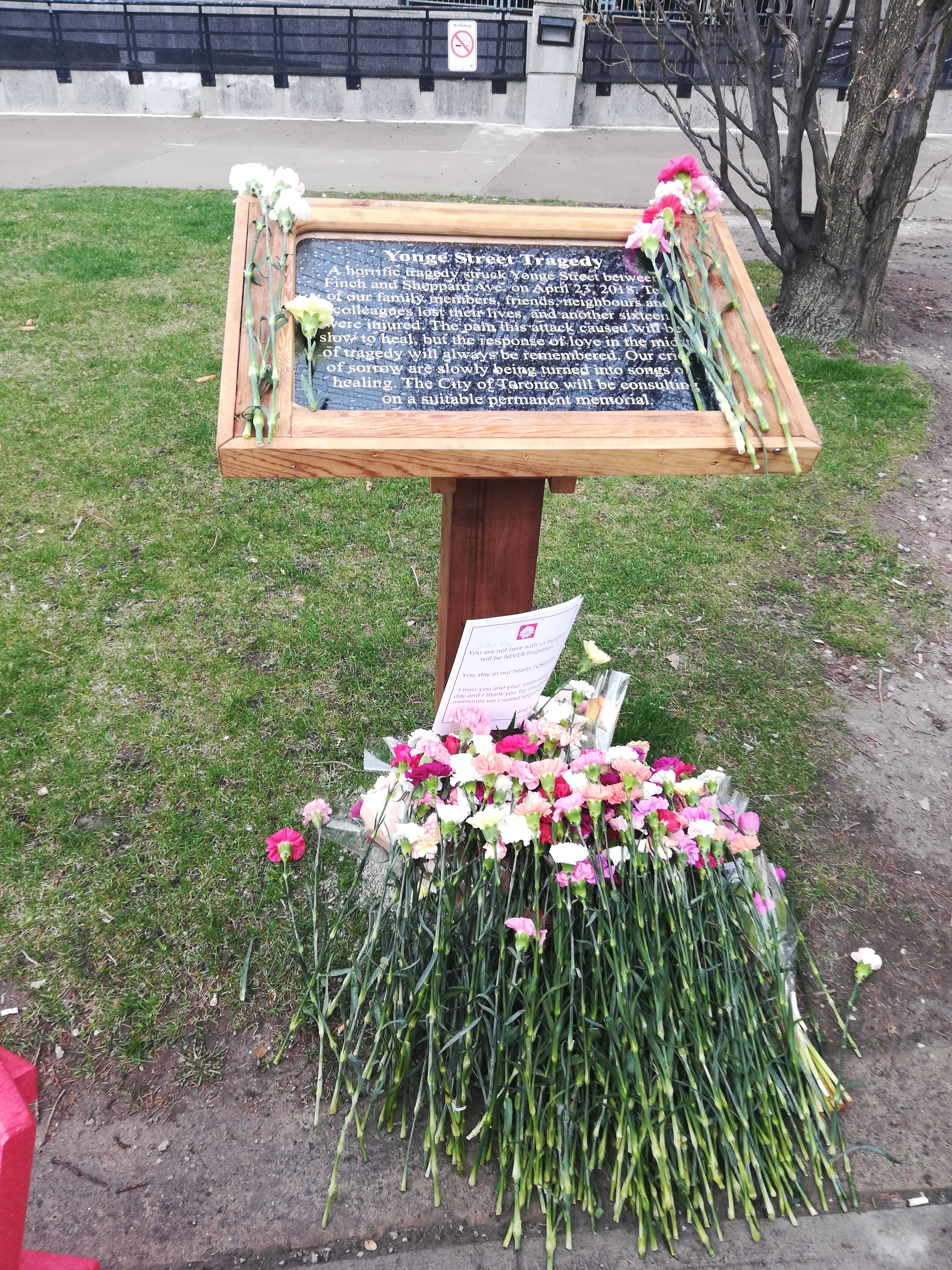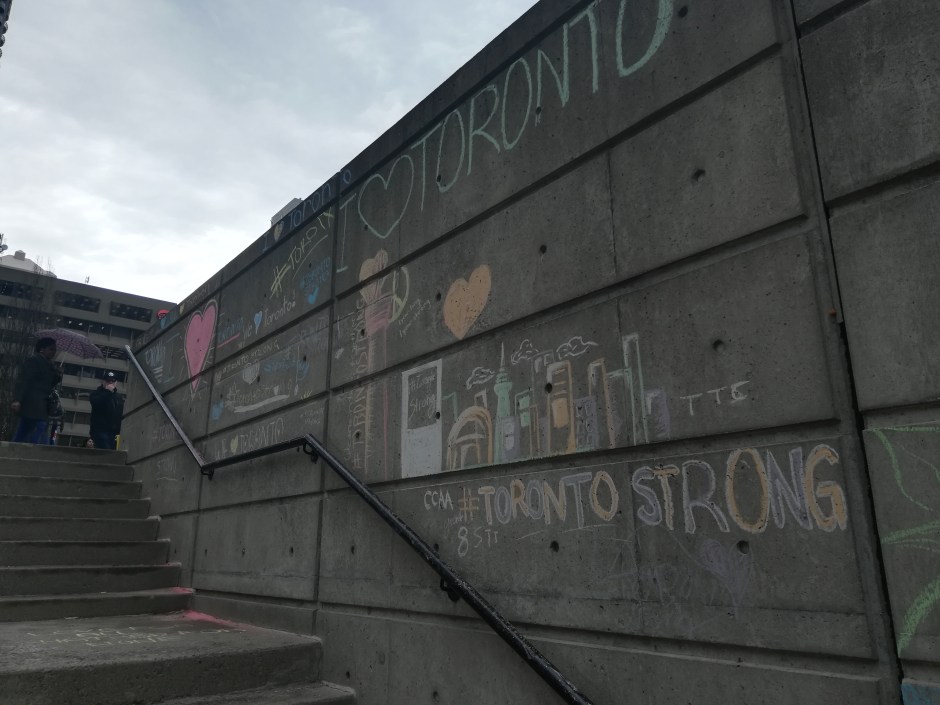A year ago, I witnessed one of Toronto’s greatest tragedies, an event that altered my view of the world. This is what I saw.
By Victoria Silman | Featured images courtesy of Victoria Silman | April 23, 2019
One year ago, the unfathomable hatred of a lonely man changed my life.
For as long as I can remember, images of tragedy committed by people with political and personal agendas flashing across 24-hour news channels have littered my life—as I’m sure they have of many others. One of my most vivid memories is watching the newscast of September 11. The video of planes flying into the side of the sky-high glass windows and burning buildings drew my attention to the 14-inch television screen in our kitchen. The TV sat up on the counter, so my tiny seven-year-old self had to stretch up on my toes to see it.
Though there is a disconnect watching tragedy on TV, this is not to say that I was ever ambivalent or naïve to mass murders around the world. However, 13 months ago, on April 23, it happened to me.
At approximately 1:30 p.m., on an unseasonably warm, sunny day, a man drove a large white rental van down the sidewalks of Yonge Street. He started at Finch Avenue, heading south, and ended up just south of Sheppard Avenue, hitting every person he possibly could in the two-kilometre stretch. His primary goal was to hit women. In the hours following the tragedy, April 23 would soon become synonymous with the “Toronto Van Attack.”
The suspect identified himself as an “incel”—short-form for “involuntarily celibate,” a term coined by the occupiers of the deep, dark web. Consisting of mostly men, this culture derives their hatred towards women from their lack of success at dating them.
While I had previously heard of this underground culture (mostly in passing), I never really envisioned my life to be directly affected by it.
But every day I look out my 11-floor apartment window at Earl Bales park, I’m reminded of it. Just beyond the serenity of the evergreen forest and suburban streets lies a stretch of skyscrapers lining Yonge street where the attack occurred—a constant image of the things I saw that day.
Like 9/11, me driving north on Yonge from Sheppard on that balmy Monday is still one of my most vivid memories. You never forget pools of crimson blood and bodies strewn along a busy street.

Following the attack, a memorial was established at Mel Lastman Square | Victoria Silman | April 29, 2018.
Amid the chaos, a horrible silence descended on the street—an aura of shock in the air clouding over the shining sunlight.
My partner and I were initially on our way to a gym near York Mills Road when we were rerouted due to deadlocked traffic heading south on Yonge just passed Sheppard. We speculated there could be construction; however, we would later learn that the suspect was being apprehended only a few metres from where we were.
We decided to head north instead to eventually make our way to York University’s gym. Having been rerouted, we made our way north on Doris, eventually turning onto Elmwood, the street leading to Mel Lastman Square.
Passing by the square, I distinctly remember a man in beige pants performing CPR on what appeared to be a woman in a dark, knee-length skirt on the ground near some planters. Next to him, a woman was doing the same for another individual whom we couldn’t see. I initially thought perhaps it was a CPR course. There seemed to be hundreds of people populating the square—perhaps there was an event going on.
It wasn’t until we drove a little more north and spotted a glass bus shelter shattered on the sidewalk, people lying on both sides of the street, and first responders speeding towards us, that we realized something terrible had happened. Newscast images from truck attacks in Nice and Barcelona must have been embedded in my subconscious, because I distinctly remember thinking to myself “only a vehicle could have caused this carnage.”
As we continued driving, time seemed to slow down as first responders began arriving in the opposite direction we were travelling. Police cars jumped curbs in an effort to get to victims quickly. One officer on foot covered the face of a victim—a man I recognized once the names of the victims were released— lying on the side of the road before he set off to help another.
It didn’t really hit me until fiery orange body bags began engulfing the street.
My recollection of the events of that day is framed by one person I spoke to: Rachel Hernandez, a young, vibrant 22-year-old, who worked at Jack Astor’s, which faces Mel Lastman Square. She witnessed the aftermath of the attack.
Initially, Hernandez noticed some commotion outside, but didn’t think it was a major emergency. She saw a person performing chest compressions on someone lying on the ground but assumed they may have had a heart attack on the sidewalk. Little did she know 10 lives were ending on the stretch of Yonge Street she walks down every day.
That was the first time I saw the body bags—we could see Mel Lastman Square from the booths on the second floor.
It wasn’t until half an hour later that she realized the situation was far more serious. “That is when we noticed there were a lot of ambulances outside the restaurant. I kept working, but guests started crowding to get near the windows and kept looking out,” she says.
“Some of our coworkers started to get near the windows, too. I thought ‘ok something is happening,’ so I went over to the windows. That was the first time I saw the body bags—we could see Mel Lastman Square from the booths on the second floor. It was extremely shocking.”
Guests at Jack Astor’s checked the news, informing Hernandez and the rest of the staff what had happened just steps from their work. “I was shocked—a van attack happened right outside our restaurant. It was really scary,” she says. In this time, officers came in looking for witness statements, bringing her into the reality of the situation.
Jack Astor’s staff had cleared out the rest of the guests, and, after providing statements to police, they gathered around the bar on the first floor to watch CP24 on the slew of televisions on the wall. Watching the story unfold, they cried together.
Some time later, as I sat at home, lying shocked and dazed with bloodshot eyes from crying for hours following the attack, Hernandez was getting ready to leave work. Police informed her and other staff at Jack Astor’s that they would require a police escort armed with an assault rifle to leave the building and head to their transportation. Stepping onto the street alongside the officer brought a range of emotions to her.
“It was so eerie—we walked out of Jack’s and the streets were completely empty. Only police officers and ambulances were there. An officer with a rifle was escorting us to a block or two down,” she says.
On April 24, the day following the attack, I went with my roommate to Mel Lastman Square to lay flowers on our way out of the city. Crime scene cleaners were just finishing spraying blood from the sidewalk when we arrived. It was cloudy and grey, and the sunny day accompanied by aura of shock from the previous day had turned into a sprinkling of rain and the pouring of grief down on the city.

Community members laid flowers in and around the large planter at the corner of the square near Starbucks. Throughout the week, letters, candles, and bouquets began flowing past the bright red Muskoka chairs near the planter. Signs proclaiming “love for all, hatred for none” stuck out behind the overflowing flowers. Just down the street at Finch, a group of mourners
The months following allowed for the community to gain some semblance of normality. The skies became brighter and the weather warmer, though witnesses and victims continued to deal with the mental, emotional, and physical scars from their traumas.
Sometimes when I’m walking down a street in Toronto, I catch myself holding my breath and my heartrate rising as a large white van drives by—perhaps a common reaction from others who witnessed the same horrors.
When I spoke to Hernandez in November, I asked her how the attack has affected her life in public. “Today I went to the bank right by Yonge and Finch,” she said. “Even now when I walk, I do so closer to the building instead of next to the road. I’m still kind of traumatized from it.”
It’s been exactly a year since a self-proclaimed incel ran down 26 people, killing 10, critically wounding 16 others, and altering the lives of hundreds of witnesses. Since then, other tragedies have held my attention with unrelenting force. The Danforth shooting, and the Christchurch attack both kept me up until the early hours of the morning, recounting my emotions and experiences in witnessing the death of multiple people.
Reflecting in the late of the night, I always remember the flaw in my thinking 13 months ago. While it feels these tragedies always happen to other people, we must not forget that other person could be you.
Victoria is a freelance writer, Executive Editor, Developer for The Scribbler. For inquiries, please contact her at victoriamsilman@gmail.com.

